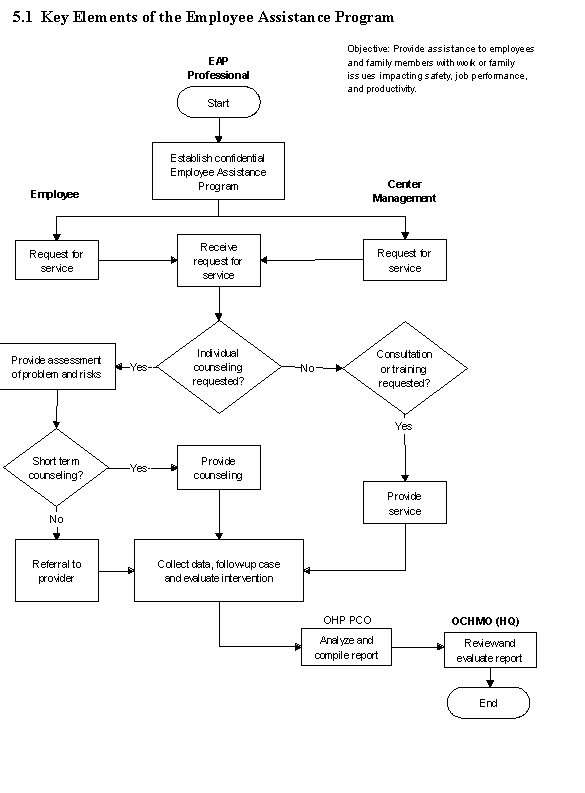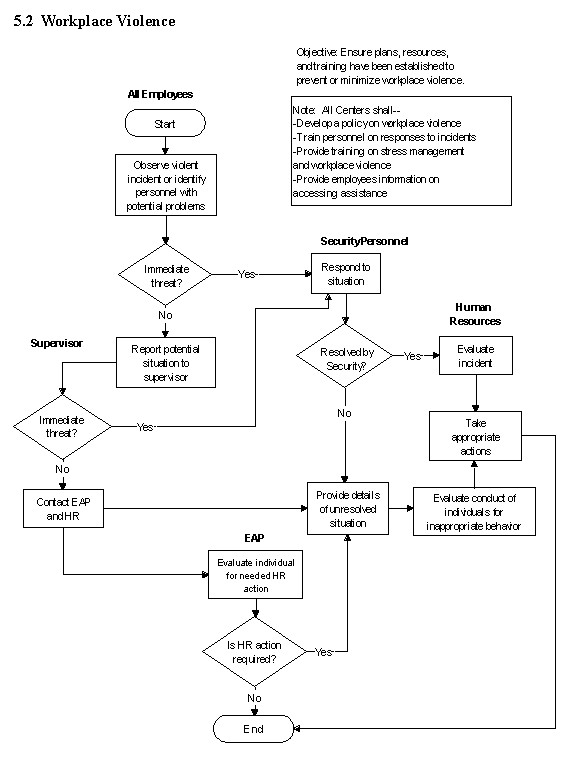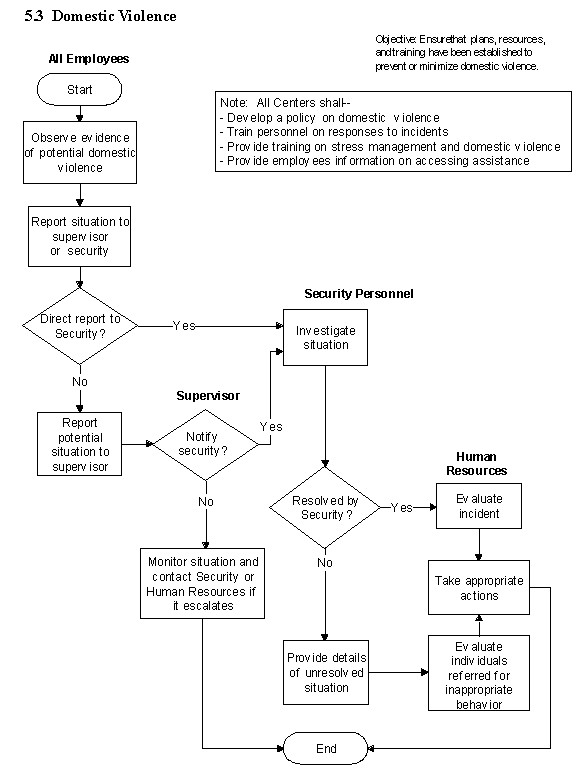Chapter 5. Employee Assistance Program
5.1 Key Elements of the Employee Assistance Program
5.1.1 Introduction
The NASA Employee Assistance Program (EAP) is a
multifaceted approach for assisting employees and their immediate families to
address work and family life issues that might affect the employee's health
and well-being, the safety of the employee and coworkers, or job performance and
productivity. The EAP provides
confidential services and ensures privacy and confidentiality with a few
specific exceptions. The service is
free for all NASA civil service employees.
5.1.2 Responsibilities
a. All NASA
Centers are responsible for providing adequate professional staffing to ensure
an effective EAP program.
b. The NASA
EAP Managercoordinates Center activities, implements
Agency EAP plans and programs, works to assure confidentiality, and provides
assistance to EAP professionals regarding implementation of Center programs such
as smoking cessation and stress reduction.
5.1.3 Process Description
a. Short-term
counseling involves from one to several sessions, over a discrete period of
time, as determined by the EAP professional.
EAP counseling service does not include clinical evaluation or diagnosis
but constitutes at least the following:
(1) Counsels employees by voluntary self-referral or
by supervisory referral to the EAP.
(2) Informs employees or other eligible participants
of client confidentiality rights and of length and type of services
provided by the EAP.
(3)
Provides problem assessment, use of constructive confrontation and
short-term intervention and assists with providing information for referrals
directed to community-based resources.
(4)
Refers clients for other assistance and treatment, advising on cost of
any such outside treatment which must be borne by the client.
(5)
Follows up on each case to ensure that continuity of care is provided or
to identify reasons the client did not complete care.
(6)
Collects overall metrics (without references that can be traced to an
individual client) on numbers and types of cases, mandatory and nonmandatory
referrals, and general demographic data.
(7) Establishes
employee feedback and quality control measures to document the degree of
effectiveness of programs while assuring confidentiality.
b. The EAP
professional is involved in developing and participating in work/life programs. This includes programs such as Critical Incident Response or
Prevention/Threat Assessment teams, American with Disabilities Act, and
Drug-Free Workplace Program (DFWP) groups.
At each Center, the EAP professional is the designated point of contact
for the above programs who is responsible for the following:
(1)
Works with Center employees and management groups to provide for early intervention
and awareness of the programs offered.
(2) Offers
training and consultation to employee groups.
(3) Establishes
employee feedback and quality control measures to document the degree of
effectiveness of programs while assuring confidentiality.
5.1.4 Flow Diagram
The flow diagram for this process is shown in Figure at the end of this section.

5.2 Workplace Violence
5.2.1 Introduction
Workplace violence has become an important health and safety
concern in today's workplace. Acts
of violence are costly in terms of lost workdays, lost productivity, and
increased healthcare expenditures. Violence
is defined as any act against an individual that creates a hostile environment
and/or negatively affects an individual either physically or psychologically.
NASA's top priority is the health and safety of the visiting public,
the astronauts, and employees. Tolerance
will not be shown, therefore, for acts of violence, harassment, threats,
intimidation, and other disruptive behavior.
5.2.2 Responsibilities
a. NASA Center
Human Resources personnel ensure that employees are informed of Center's
policy, ensure a mechanism to report concerns or incidents, and coordinate
necessary actions when an incident has occurred.
b. EAP and medical services personnel ensure training
is available on violence and stress management.
c. Center
Medical Directors assist EAP personnel with training of Center personnel to
reduce workplace violence, treat medical emergencies associated with an incident
of workplace violence, and evaluate or refer for evaluation suspected cases
involving a psychiatric, alcohol or drug-related problem
d. Security personnel respond to
all potential incidents and provide protection with as little disruption as
possible.
5.2.3 Process Description:
a. Develop a Center policy concerning workplace
violence in all forms.
b. Ensure training on Center policy, stress
management, and workplace violence.
c. Identify problems early and resolve them to
prevent workplace violence.
d. Identify in the policy the mechanism, person, and
telephone number to contact if there is an emergency situation and if there
is a nonemergency developing problem or concern.
e.
Ensure that the security personnel are well-trained to handle developing
situations with as little disruption and escalation of the situation as
possible, while iensuring Center and personnel safety.
f.
Evaluate psychiatric, alcohol, or drug-related behavior.
g. Address with employees the stress, grief, and
security concerns if a workplace violence situation develops.
5.2.4 References:
a.
The CDC Web site at www.cdc.gov/niosh/violdev.html
b.
The OSHA Web site at www.osha.gov/oshinfo/priorities/violence.html
5.2.5 Flow Diagram
The flow diagram for this process is shown in Figure
5.2 at the end of this section.

5.3 Domestic Violence
5.3.1 Introduction
a. Domestic
violence is chronic abuse by one current or former intimate partner against the
other or their dependents. It is characterized by a pattern of
coercive control and increasing entrapment.
Occurrence and severity of domestic violence may increase with stress,
financial difficulties, and job insecurity.
b. Awareness
of the potential for domestic violence and steps to be taken to prevent it are
important to ensure the safety of the affected employees.
It will help to assure a safe and productive working environment.
Employees must be provided with education and resources to increase their
awareness that may help prevent or stop domestic violence.
It is important for supervisors and coworkers to understand the nature
and dynamics of domestic violence to help provide proper intervention.
5.3.2 Responsibilities
a. The employee's supervisor is the key individual for
identifying problems through observing unusual performance, physical evidence of
repeated trauma, and emotional problems that need to be addressed.
b. Center EAP
personnel provide consultation to management on employee problems, allow for
easy confidential access to services, and provide information on community and
Center contacts concerning domestic violence.
c. The Center Medical Directors ensure that health care workers
take domestic violence seriously, screen employees for domestic abuse, provide
information on domestic violence, make referrals to available resources, and
take appropriate action concerning possible domestic violence.
d. The Human Resources Director works with EAP and
medical personnel to assist with job related support needs.
e. NASA
Center Directors ensure that plans are in effect to assure employee safety at
their Centers. In addition, they
ensure professionals are available at the Center to confidentially address
employee domestic violence concerns.
5.3.3 Process Description
a.
A Center policy is prepared for a multidisciplinary approach to identify,
address, and ensure Center safety for the domestic abuse victim.
The following areas need to be addressed:
(1)
Confidentiality must be emphasized and maintained.
(2)
Security of the employee and coworkers must be emphasized, especially if
the abusive partner works at or has access to the Center.
(3) Access to
resources at the Center is essential, as the abused partner may not be free to
access services after work hours.
(4) Center EAP,
supervisory, medical, and Human Resources (HR) personnel must understand their
respective functions in dealing with domestic violence).
b. ALL reports of abuse must be taken seriously and
the individual referred appropriately for assistance.
c. Information on personnel to contact, telephone
numbers to call when someone needs assistance, and a list of community
resources should be available onsite, as well as in confidentially
accessible locations such as female bathrooms
d. Training and lectures should be made available to
employees that address--
(1) Center violence policy.
(2) Resources available.
(3) Emotional support and self-esteem or empowerment.
(4) Dynamics of abuse and barriers to ending
domestic abuse.
(5) Financial, legal, and advocacy needs.
(6) Security questions.
e. Medical staff provide instructions on the physical
and behavioral signs of abuse.
f. EAP personnel should be prepared to perform the
following:
(1) Assess danger risk to employee from abusive
partner.
(2) Provide
contacts and telephone numbers for dealing with the abusive situation in the
community, and encourage employees to memorize emergency numbers.
(3) Arrange for
onsite contact if community resources are not easily available.
(4)
Develop a "safety plan" with the affected employee to include--
(a) Preparation to leave the abusive partner,
including financial preparation, rehearsal, and necessary documents to
take.
(b) Protection during violent incidents.
(c) Safety in the home.
(d) Safety arrangements at work or public places.
g. Human
resources, legal, and security personnel should be prepared to assist, if
necessary, when the abusive partner has access on the Center to the employee
affected by domestic violence.
5.3.4 Flow Diagram
The flow diagram for this process is shown in Figure
5.3 at the end of this section.

DISTRIBUTION:
NODIS
This Document is Obsolete and Is No Longer Used.
Check the NODIS Library to access the current version:
http://nodis3.gsfc.nasa.gov
![[NASA Logo]](../Images/nasaball.gif)


